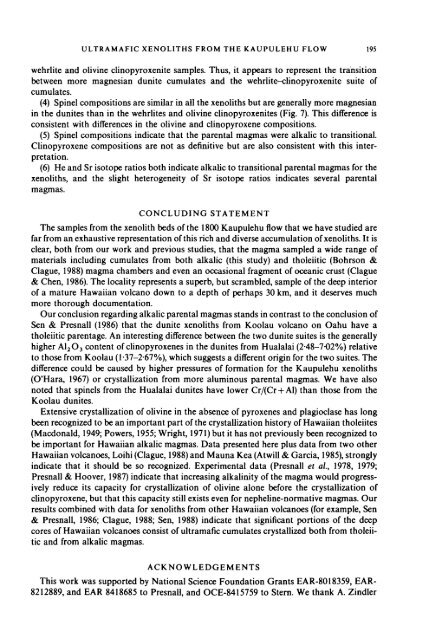Petrogenesis of Ultramafic Xenoliths from the 1800 Kaupulehu Flow ...
Petrogenesis of Ultramafic Xenoliths from the 1800 Kaupulehu Flow ...
Petrogenesis of Ultramafic Xenoliths from the 1800 Kaupulehu Flow ...
You also want an ePaper? Increase the reach of your titles
YUMPU automatically turns print PDFs into web optimized ePapers that Google loves.
ULTRAMAFIC XENOLITHS FROM THE KAUPULEHU FLOW 195wehrlite and olivine clinopyroxenite samples. Thus, it appears to represent <strong>the</strong> transitionbetween more magnesian dunite cumulates and <strong>the</strong> wehrlite-clinopyroxenite suite <strong>of</strong>cumulates.(4) Spinel compositions are similar in all <strong>the</strong> xenoliths but are generally more magnesianin <strong>the</strong> dunites than in <strong>the</strong> wehrlites and olivine clinopyroxenites (Fig. 7). This difference isconsistent with differences in <strong>the</strong> olivine and clinopyroxene compositions.(5) Spinel compositions indicate that <strong>the</strong> parental magmas were alkalic to transitional.Clinopyroxene compositions are not as definitive but are also consistent with this interpretation.(6) He and Sr isotope ratios both indicate alkalic to transitional parental magmas for <strong>the</strong>xenoliths, and <strong>the</strong> slight heterogeneity <strong>of</strong> Sr isotope ratios indicates several parentalmagmas.CONCLUDING STATEMENTThe samples <strong>from</strong> <strong>the</strong> xenolith beds <strong>of</strong> <strong>the</strong> <strong>1800</strong> <strong>Kaupulehu</strong> flow that we have studied arefar <strong>from</strong> an exhaustive representation <strong>of</strong> this rich and diverse accumulation <strong>of</strong> xenoliths. It isclear, both <strong>from</strong> our work and previous studies, that <strong>the</strong> magma sampled a wide range <strong>of</strong>materials including cumulates <strong>from</strong> both alkalic (this study) and tholeiitic (Bohrson &Clague, 1988) magma chambers and even an occasional fragment <strong>of</strong> oceanic crust (Clague& Chen, 1986). The locality represents a superb, but scrambled, sample <strong>of</strong> <strong>the</strong> deep interior<strong>of</strong> a mature Hawaiian volcano down to a depth <strong>of</strong> perhaps 30 km, and it deserves muchmore thorough documentation.Our conclusion regarding alkalic parental magmas stands in contrast to <strong>the</strong> conclusion <strong>of</strong>Sen & Presnall (1986) that <strong>the</strong> dunite xenoliths <strong>from</strong> Koolau volcano on Oahu have atholeiitic parentage. An interesting difference between <strong>the</strong> two dunite suites is <strong>the</strong> generallyhigher A1 2 O 3 content <strong>of</strong> clinopyroxenes in <strong>the</strong> dunites <strong>from</strong> Hualalai (2-48-7-02%) relativeto those <strong>from</strong> Koolau (1-37-2-67%), which suggests a different origin for <strong>the</strong> two suites. Thedifference could be caused by higher pressures <strong>of</strong> formation for <strong>the</strong> <strong>Kaupulehu</strong> xenoliths(O'Hara, 1967) or crystallization <strong>from</strong> more aluminous parental magmas. We have alsonoted that spinels <strong>from</strong> <strong>the</strong> Hualalai dunites have lower Cr/(Cr + Al) than those <strong>from</strong> <strong>the</strong>Koolau dunites.Extensive crystallization <strong>of</strong> olivine in <strong>the</strong> absence <strong>of</strong> pyroxenes and plagioclase has longbeen recognized to be an important part <strong>of</strong> <strong>the</strong> crystallization history <strong>of</strong> Hawaiian tholeiites(Macdonald, 1949; Powers, 1955; Wright, 1971) but it has not previously been recognized tobe important for Hawaiian alkalic magmas. Data presented here plus data <strong>from</strong> two o<strong>the</strong>rHawaiian volcanoes, Loihi (Clague, 1988) and Mauna Kea (Atwill & Garcia, 1985), stronglyindicate that it should be so recognized. Experimental data (Presnall et al, 1978, 1979;Presnall & Hoover, 1987) indicate that increasing alkalinity <strong>of</strong> <strong>the</strong> magma would progressivelyreduce its capacity for crystallization <strong>of</strong> olivine alone before <strong>the</strong> crystallization <strong>of</strong>clinopyroxene, but that this capacity still exists even for nepheline-normative magmas. Ourresults combined with data for xenoliths <strong>from</strong> o<strong>the</strong>r Hawaiian volcanoes (for example, Sen& Presnall, 1986; Clague, 1988; Sen, 1988) indicate that significant portions <strong>of</strong> <strong>the</strong> deepcores <strong>of</strong> Hawaiian volcanoes consist <strong>of</strong> ultramafic cumulates crystallized both <strong>from</strong> tholeiiticand <strong>from</strong> alkalic magmas.ACKNOWLEDGEMENTSThis work was supported by National Science Foundation Grants EAR-8018359, EAR-8212889, and EAR 8418685 to Presnall, and OCE-8415759 to Stern. We thank A. Zindler
















